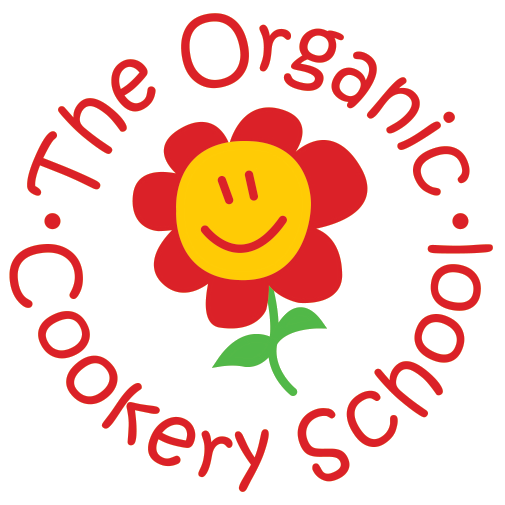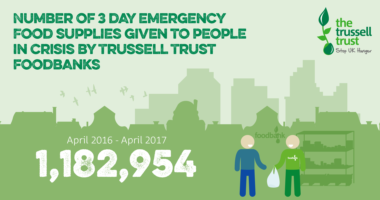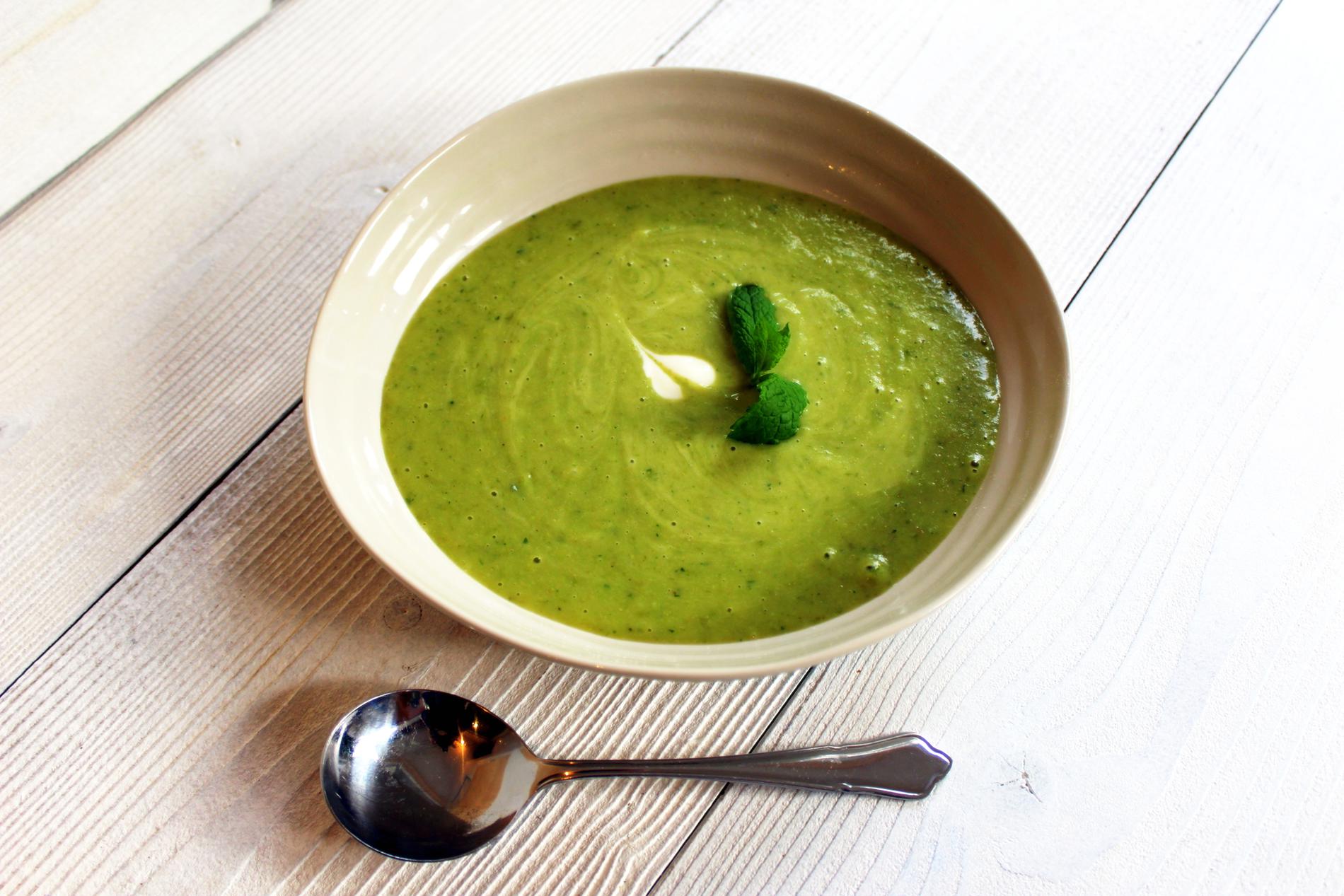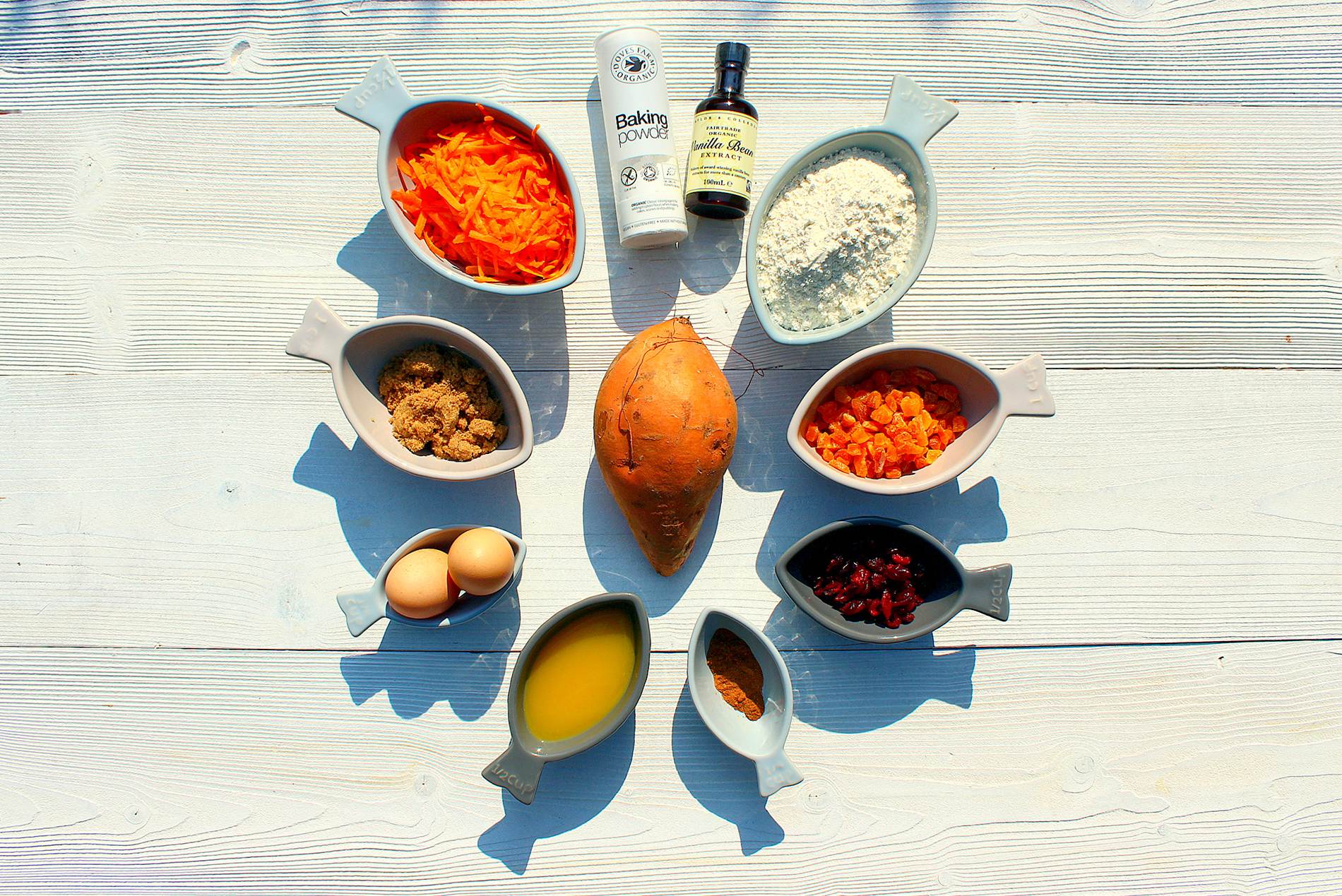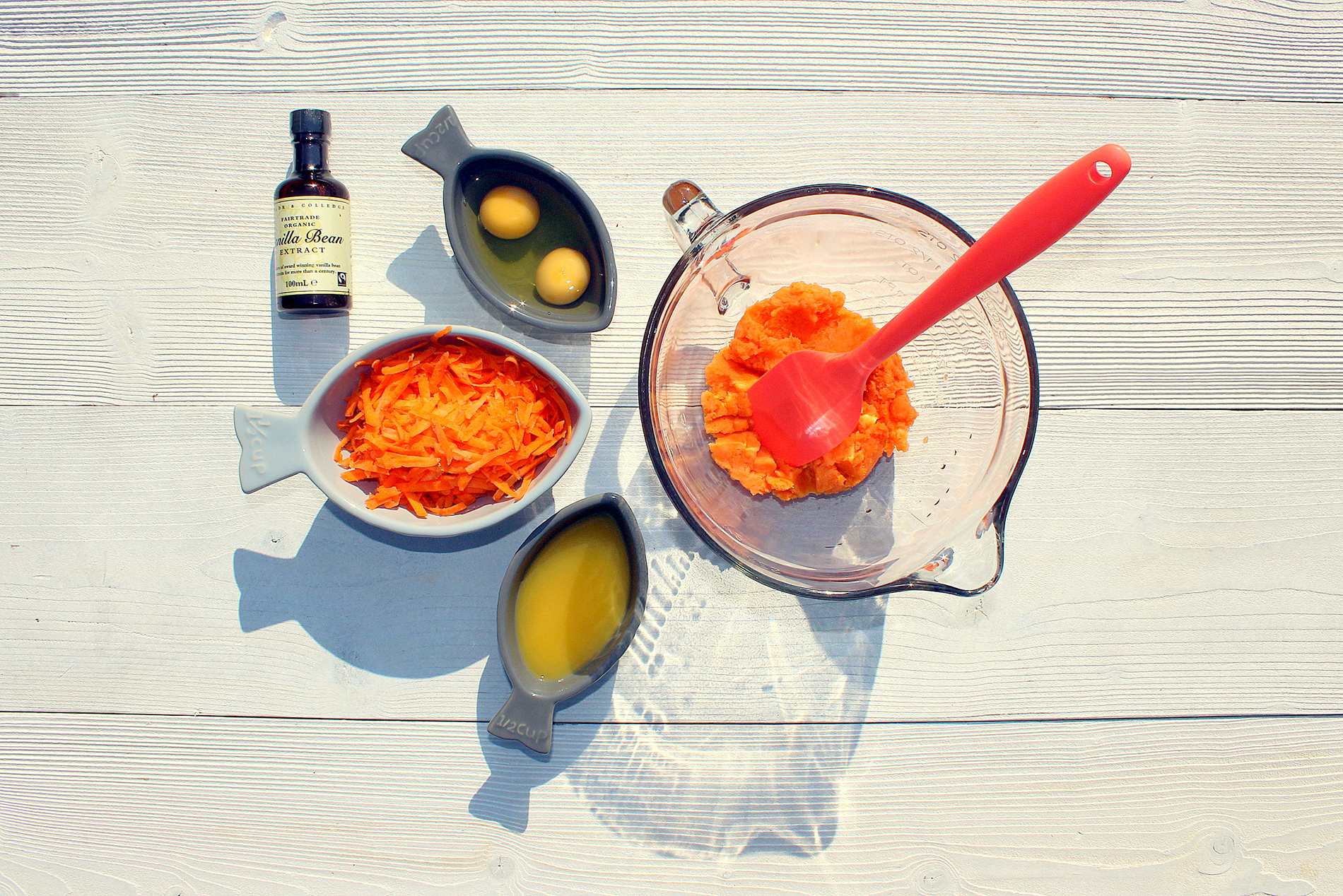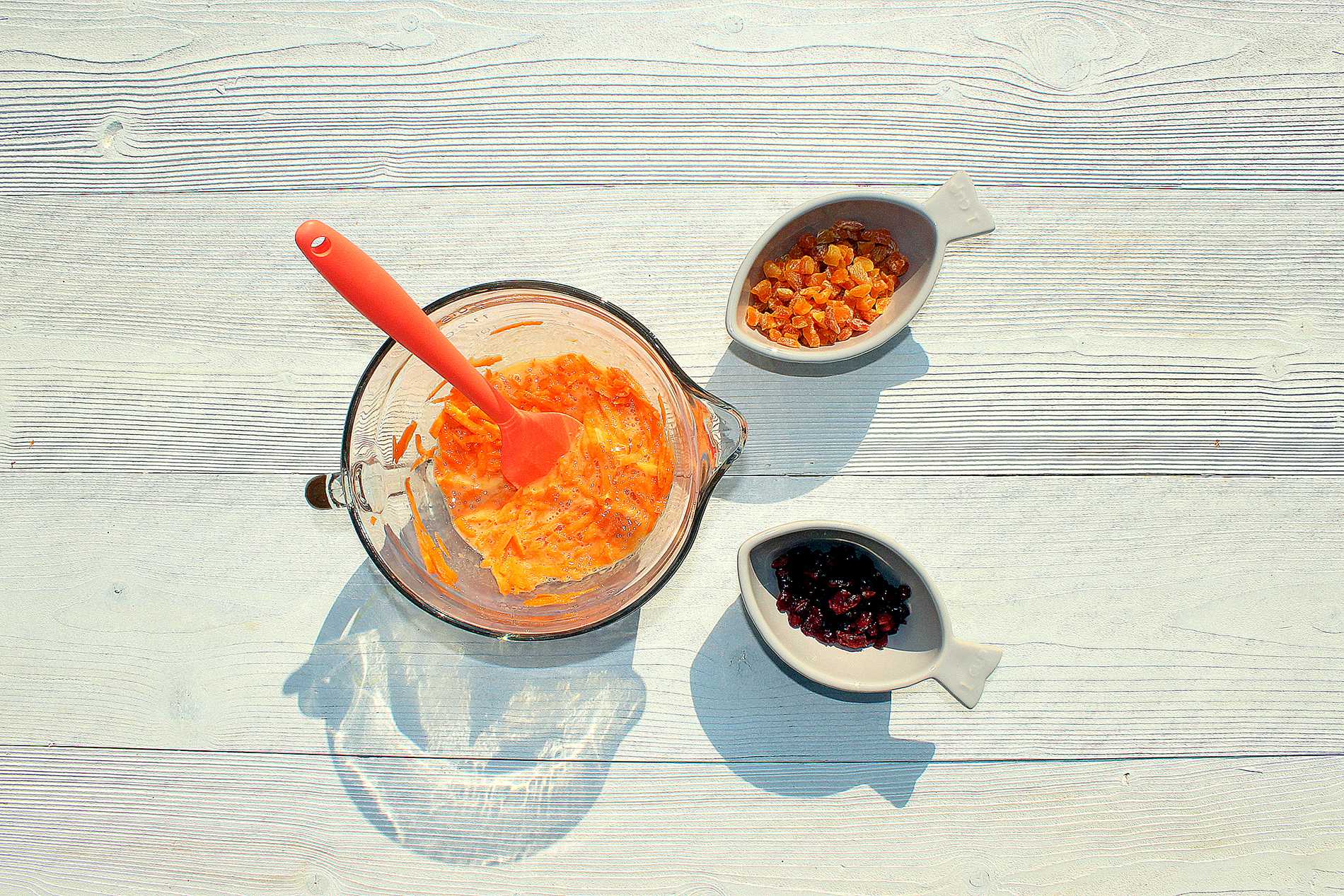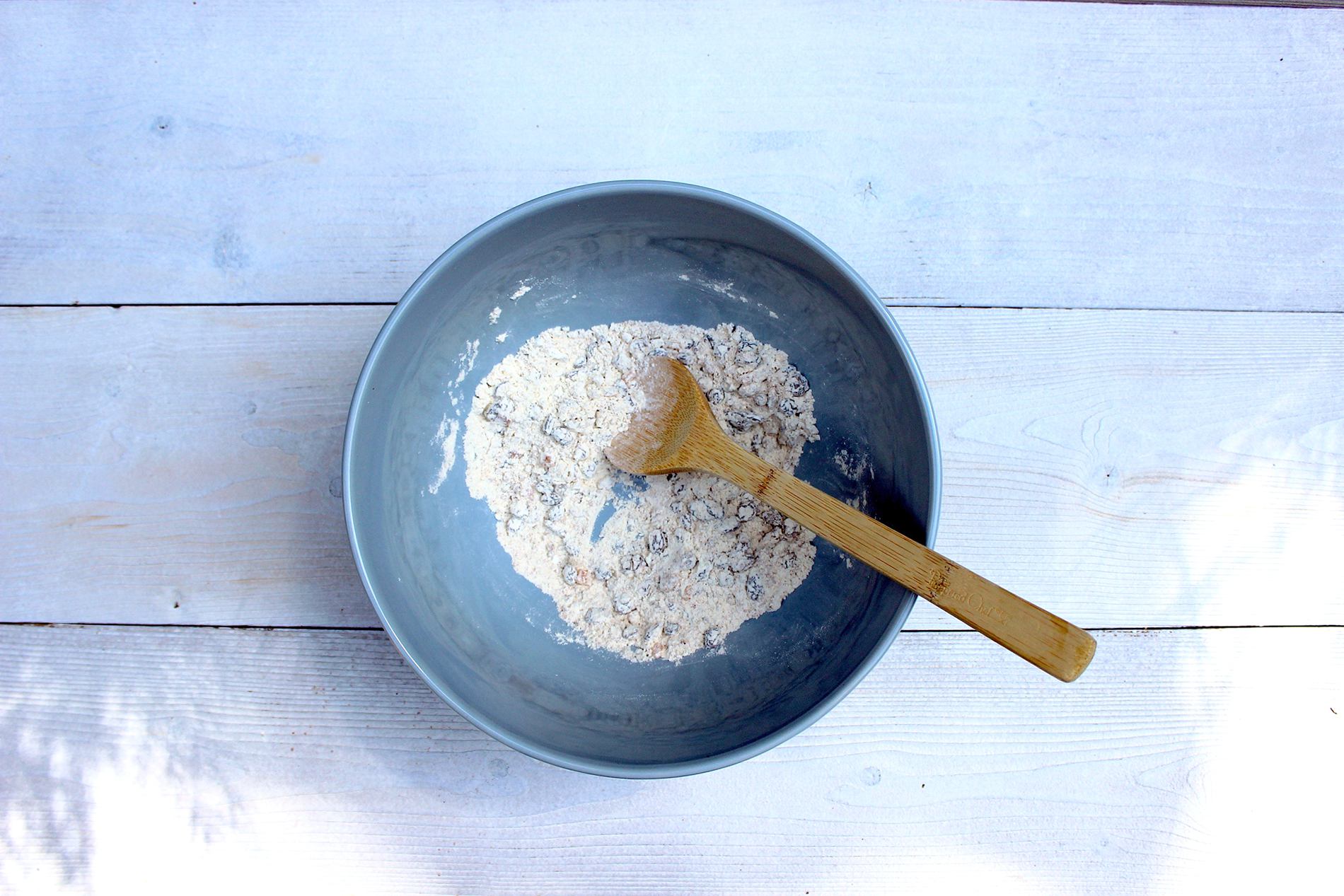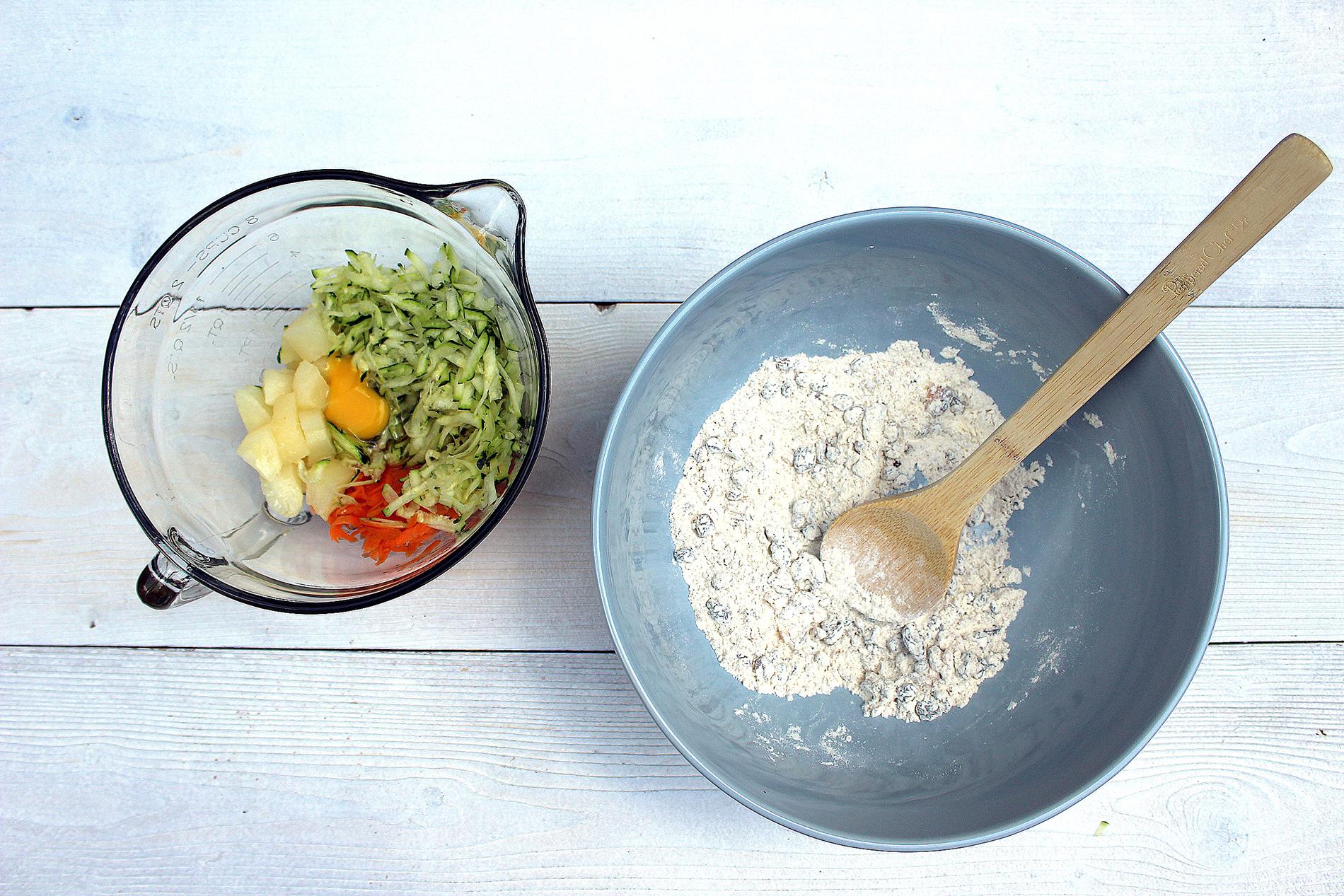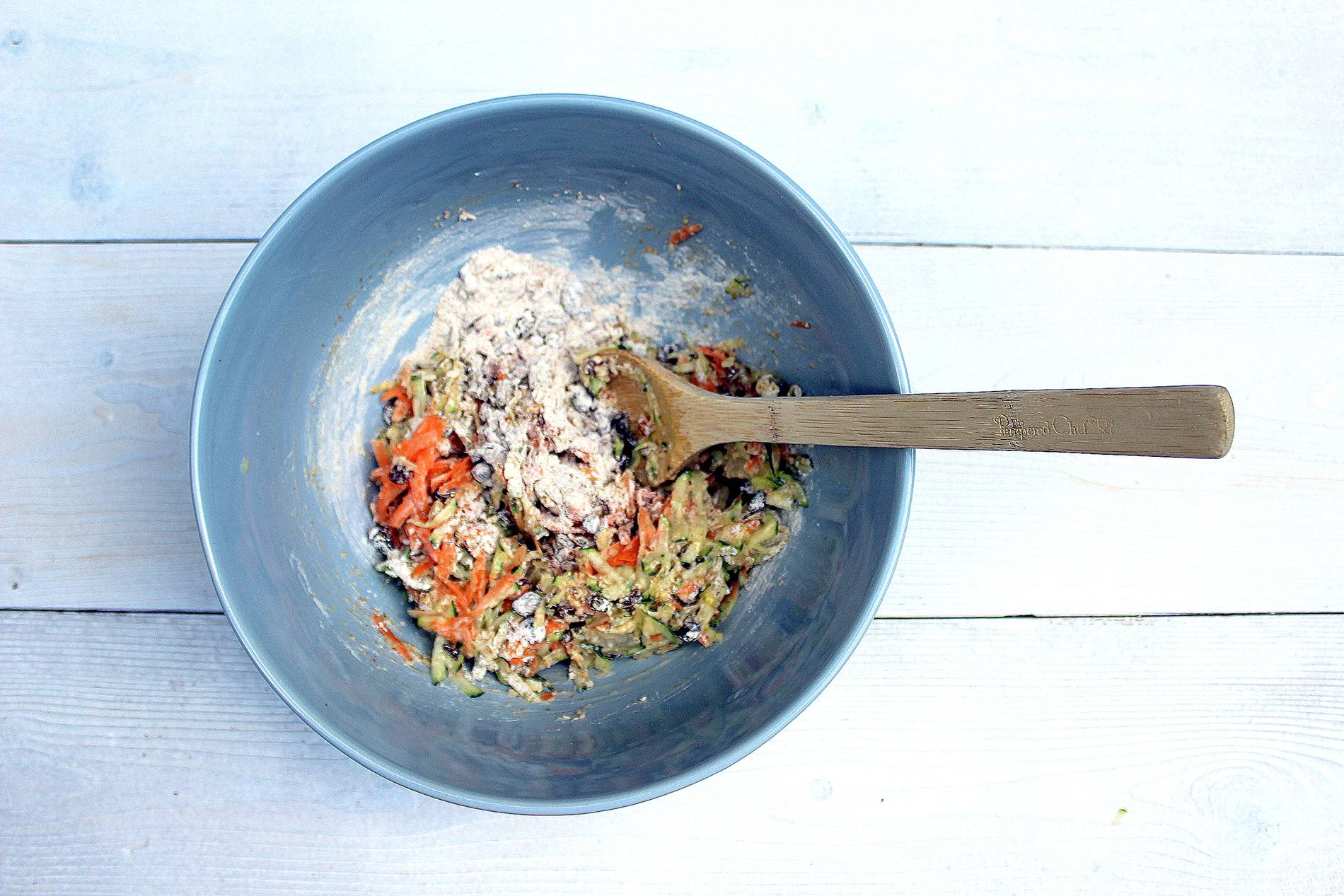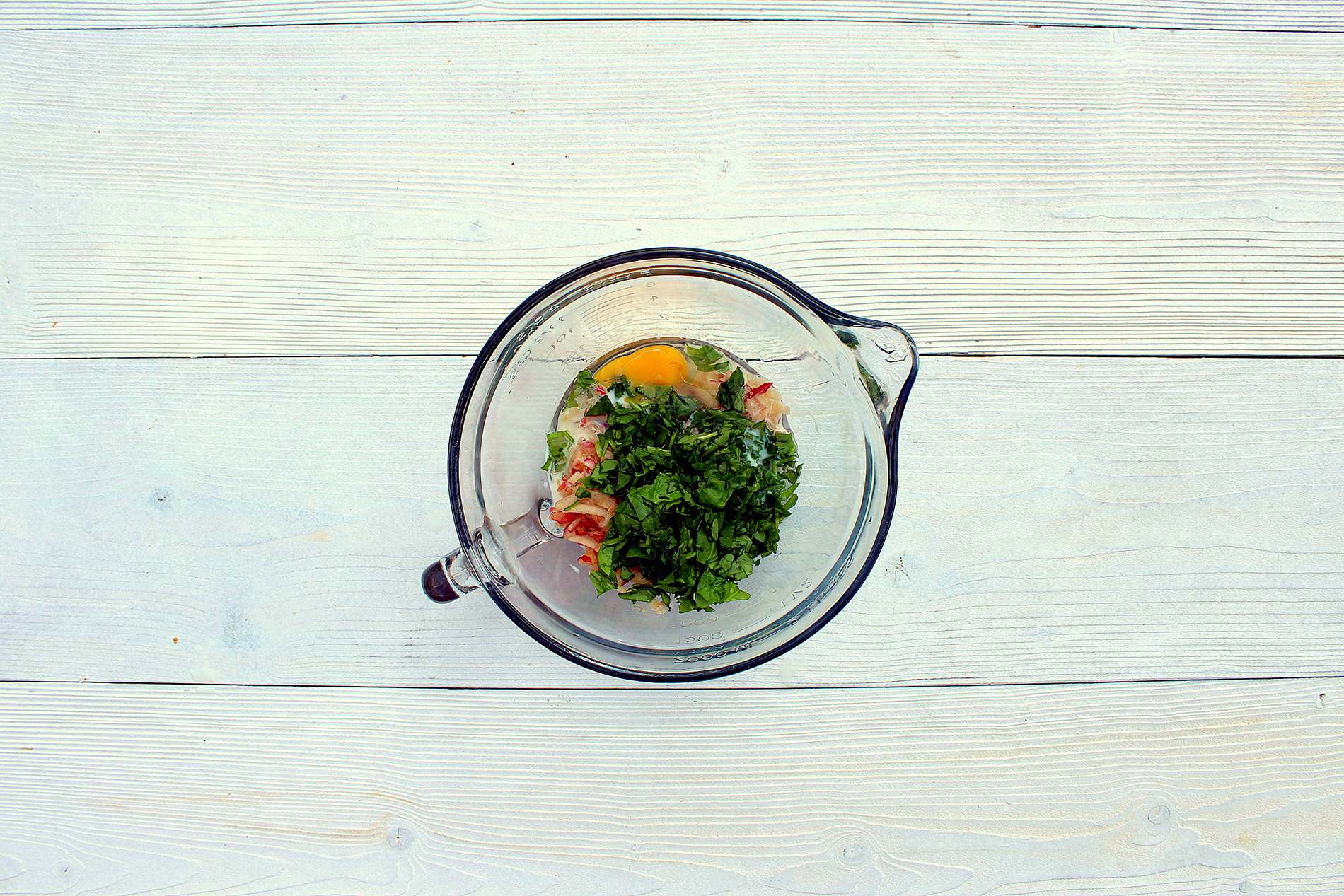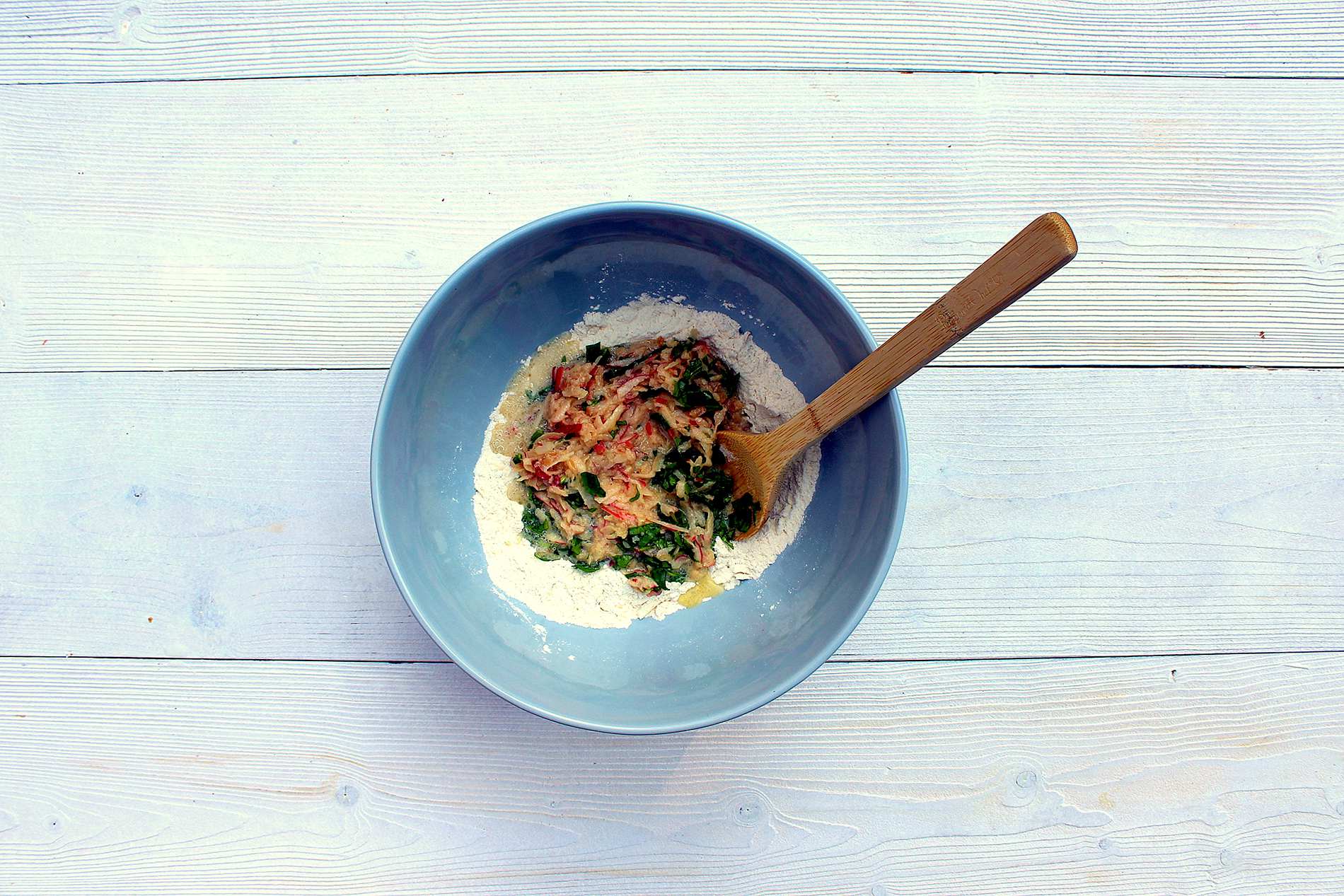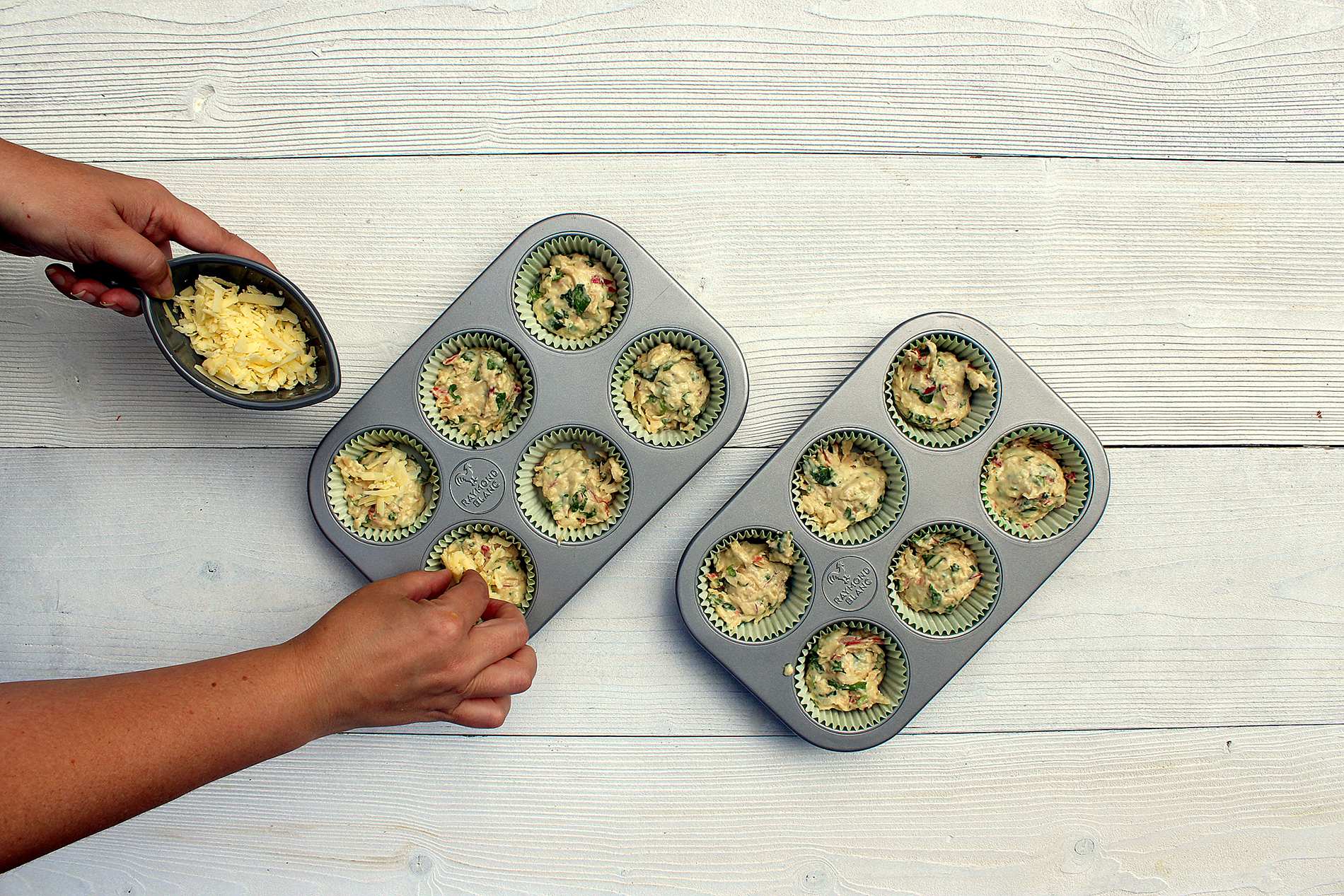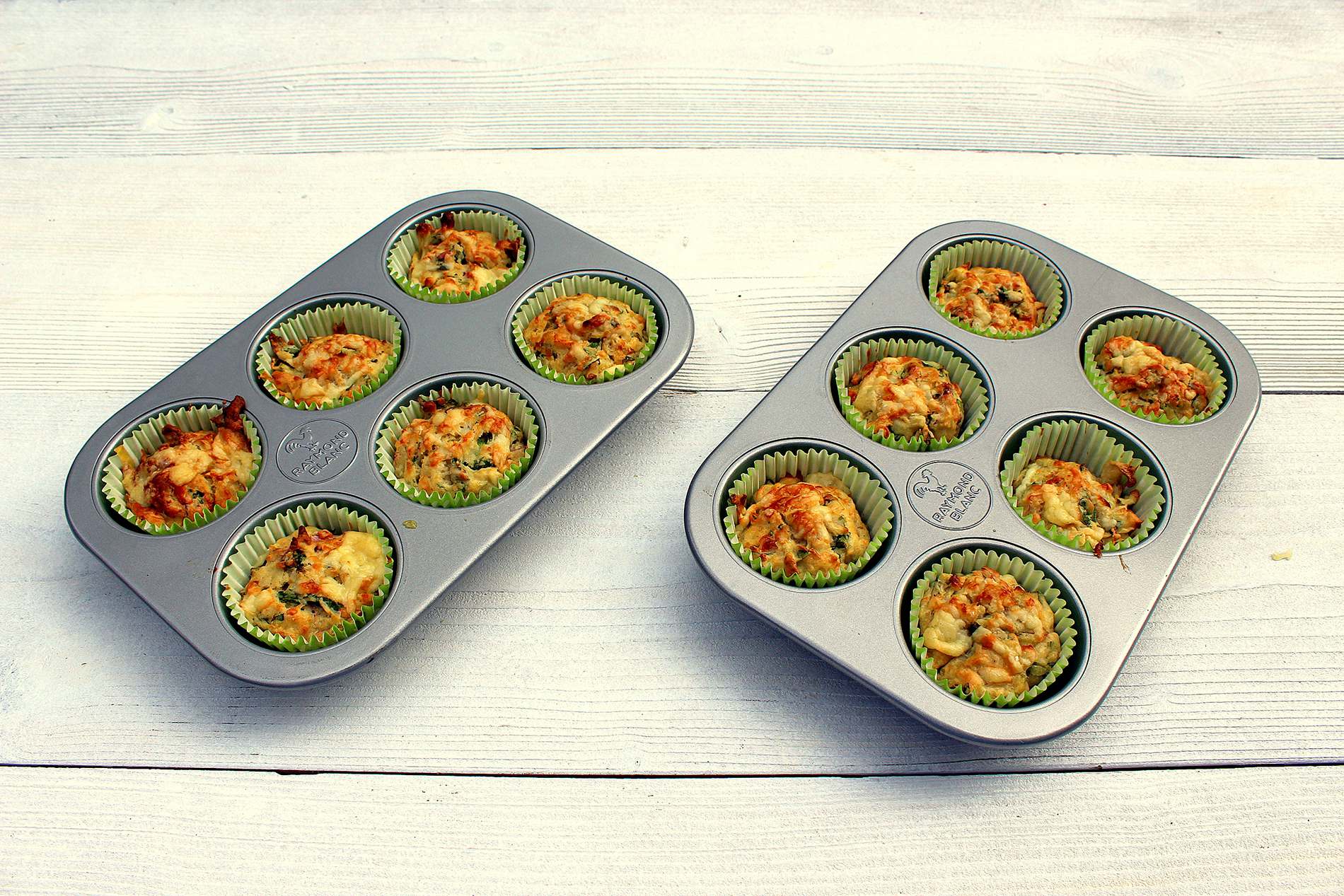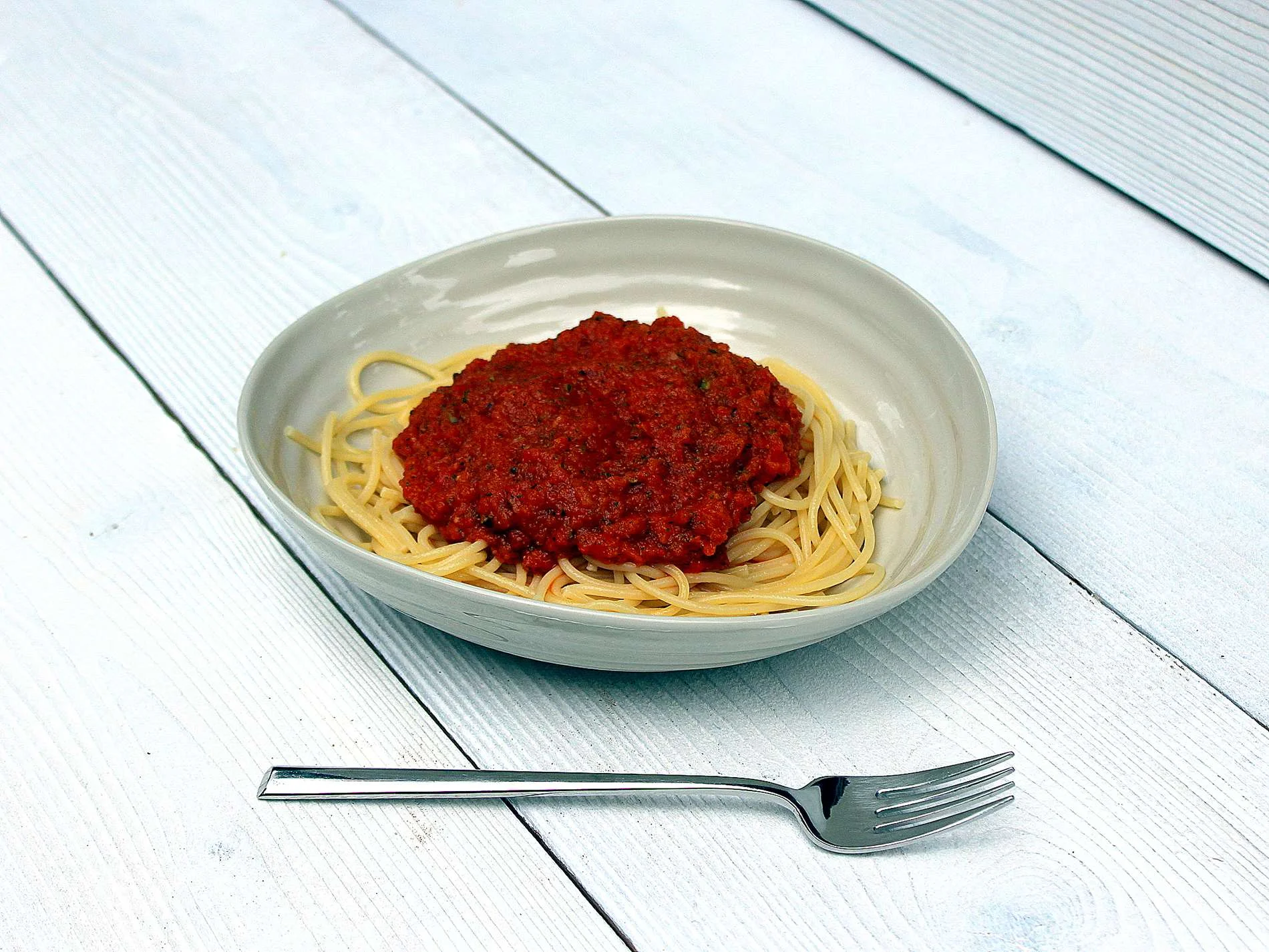Twenty kitchen skills every teen needs to know before they leave for University
Lentil Shepherd's Pie
Ultimate Crumble Recipe - with Vegan and Gluten-free Variations
Storytime Chefs : Rainbow Fish Pizzas
makes four individual pizzas
These quick and healthy pizzas are inspired by The Rainbow Fish (by Marcus Pfister), and encourage children to pile up on a variety of different coloured veggies, helping them meet their five a day targets and eat a rainbow too. I’ve honestly never seen my five year old so keen to load up with every colour of vegetable.
For speed and convenience, shop-bought pitta bread works fine (Waitrose and Ocado stock organic versions). Pitta are easy to cut to shape with sturdy kitchen scissors, and both wholemeal and white pitta both taste great in these pizzas.
Trimming into a fish shape can be a bit awkward (there’s a good chance that little ones could accidentally chop off a tail!) but is great for developing motor skills - so be prepared to model where to cut and help little ones. (and have a few pitta spare just in case)
If you want to make your own pitta (which is great fun and everso easy) - we’ve included a recipe to make your own in the resources section of our FB group.
Next comes a topping of our veggie packed magic tomato sauce, but any good quality tomato pasta sauce will work (we like Seeds of Change and Mr Organic sauces).
Let your junior chefs get busy with the cheese grater, minding their fingers (and fingernails) before offering them a rainbow selection of veggie toppings.
*N.B. Children should always be supervised when cooking, and an adult should oversee the use of heat as well as all preparation involving sharp utensils.
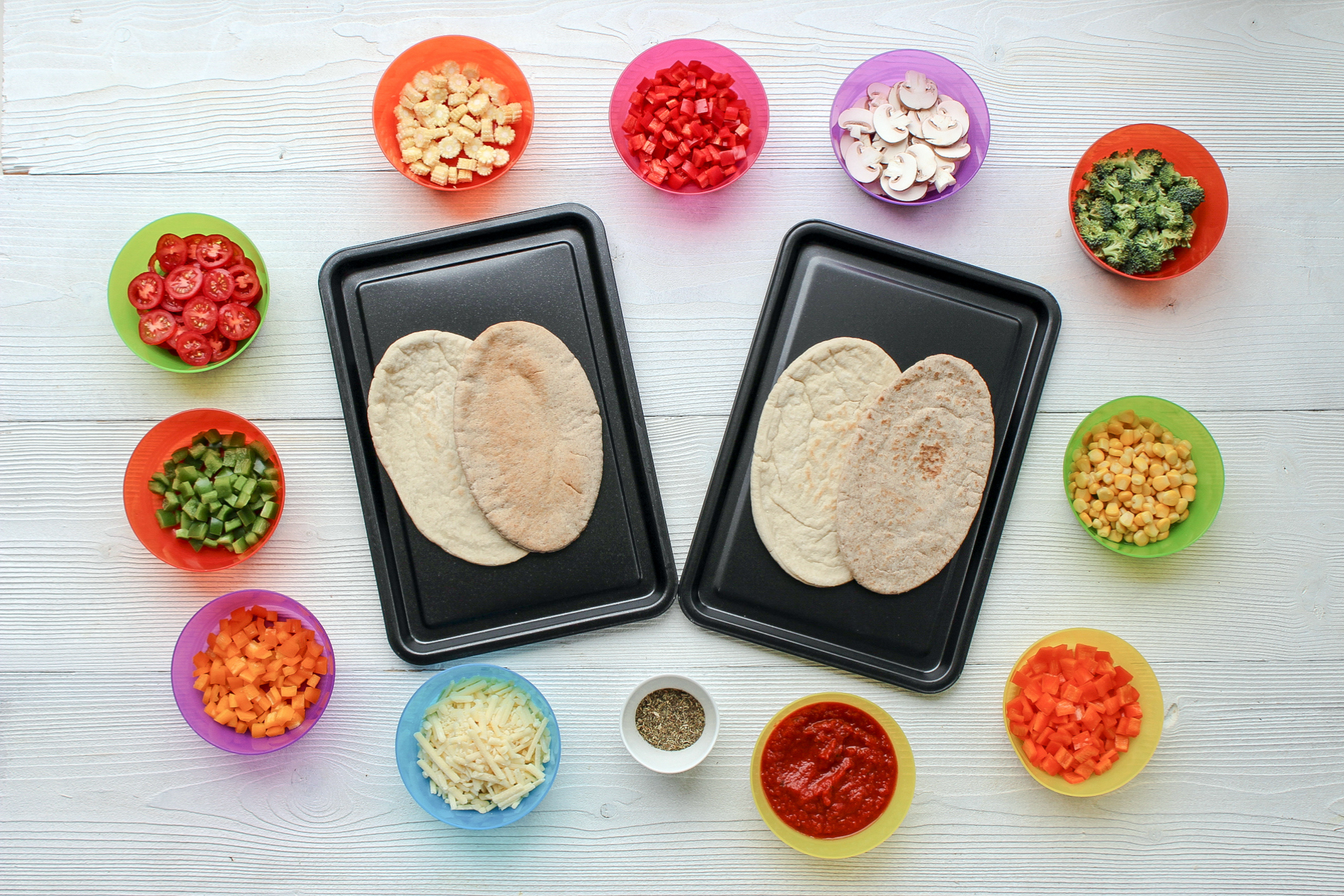
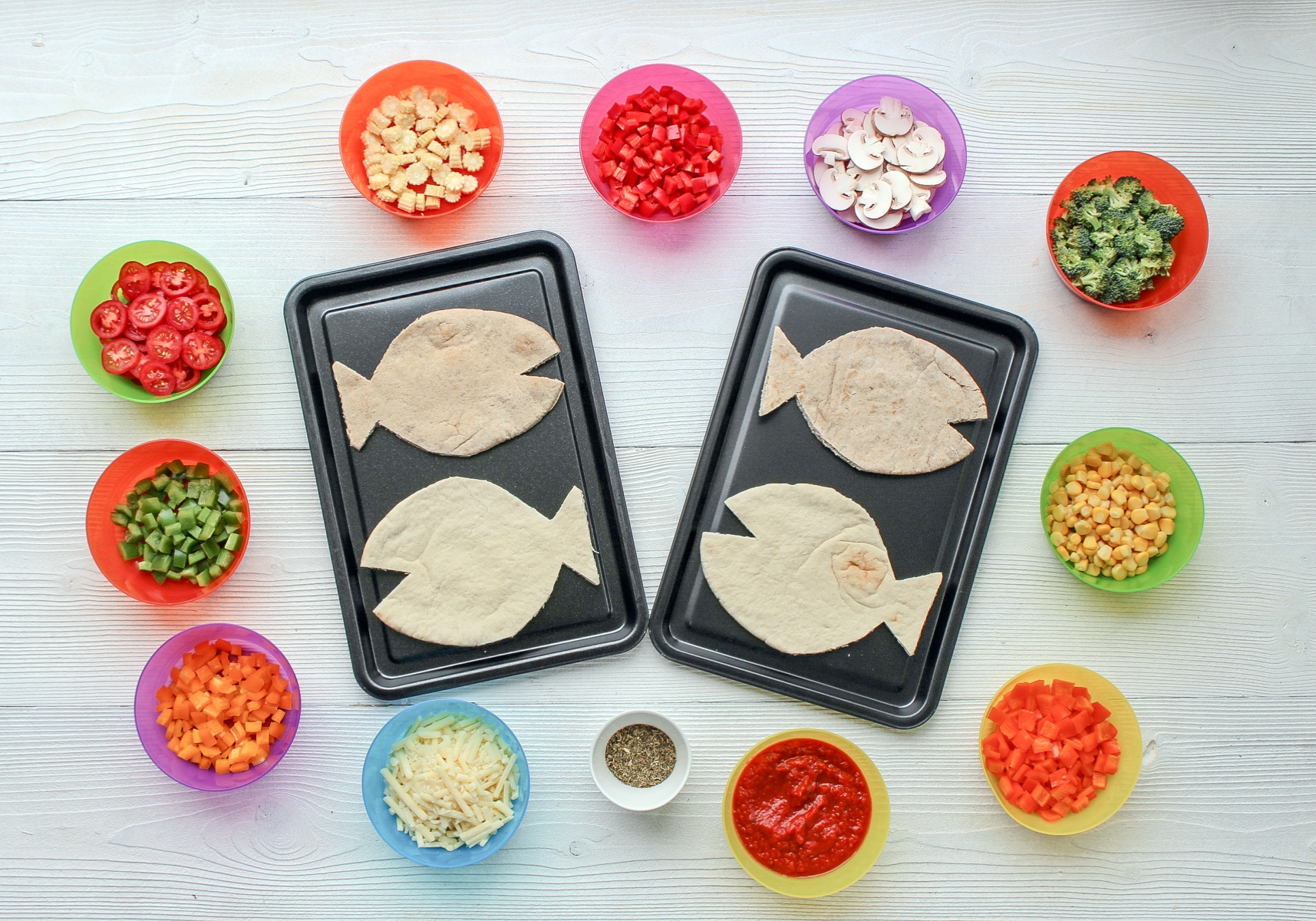
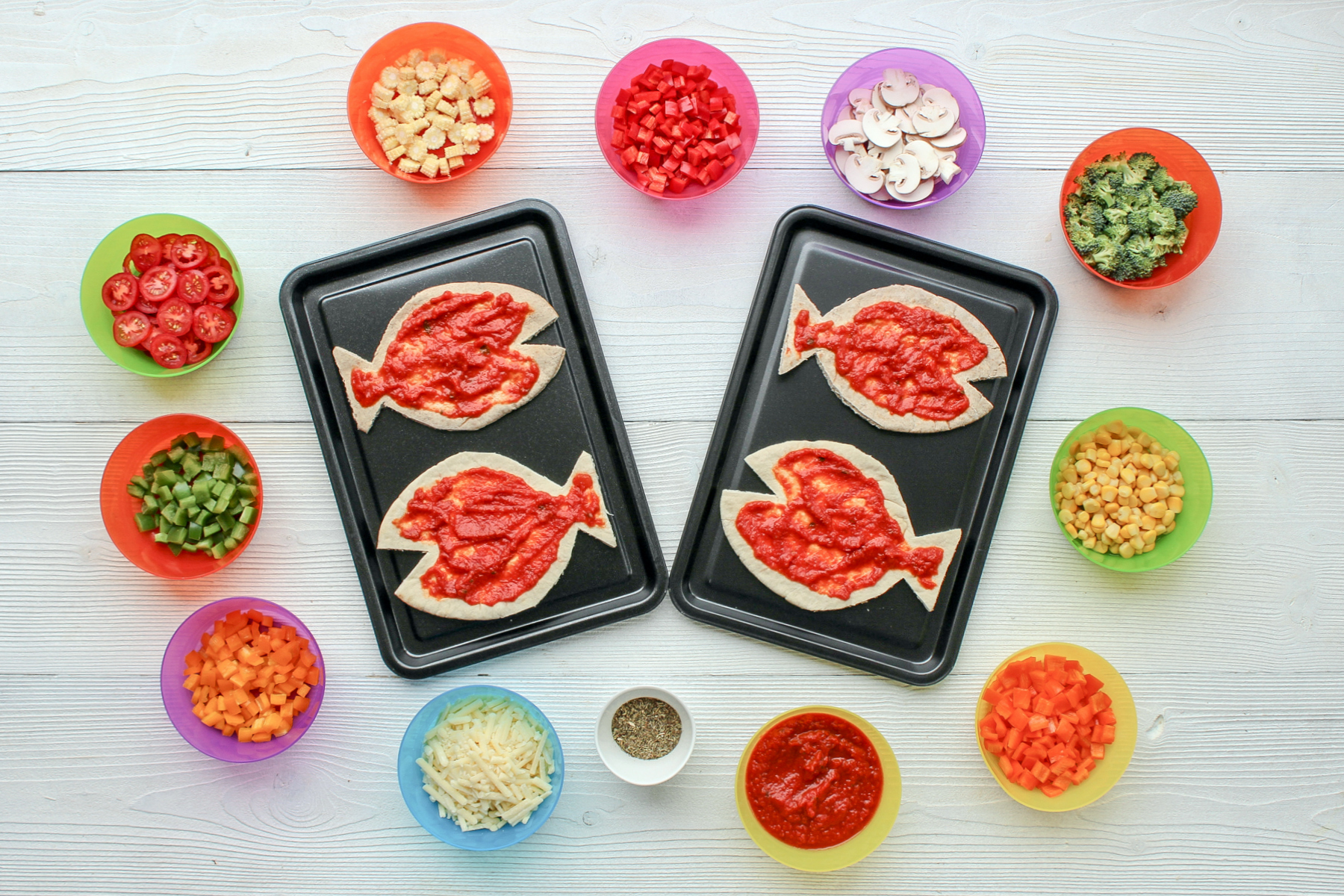

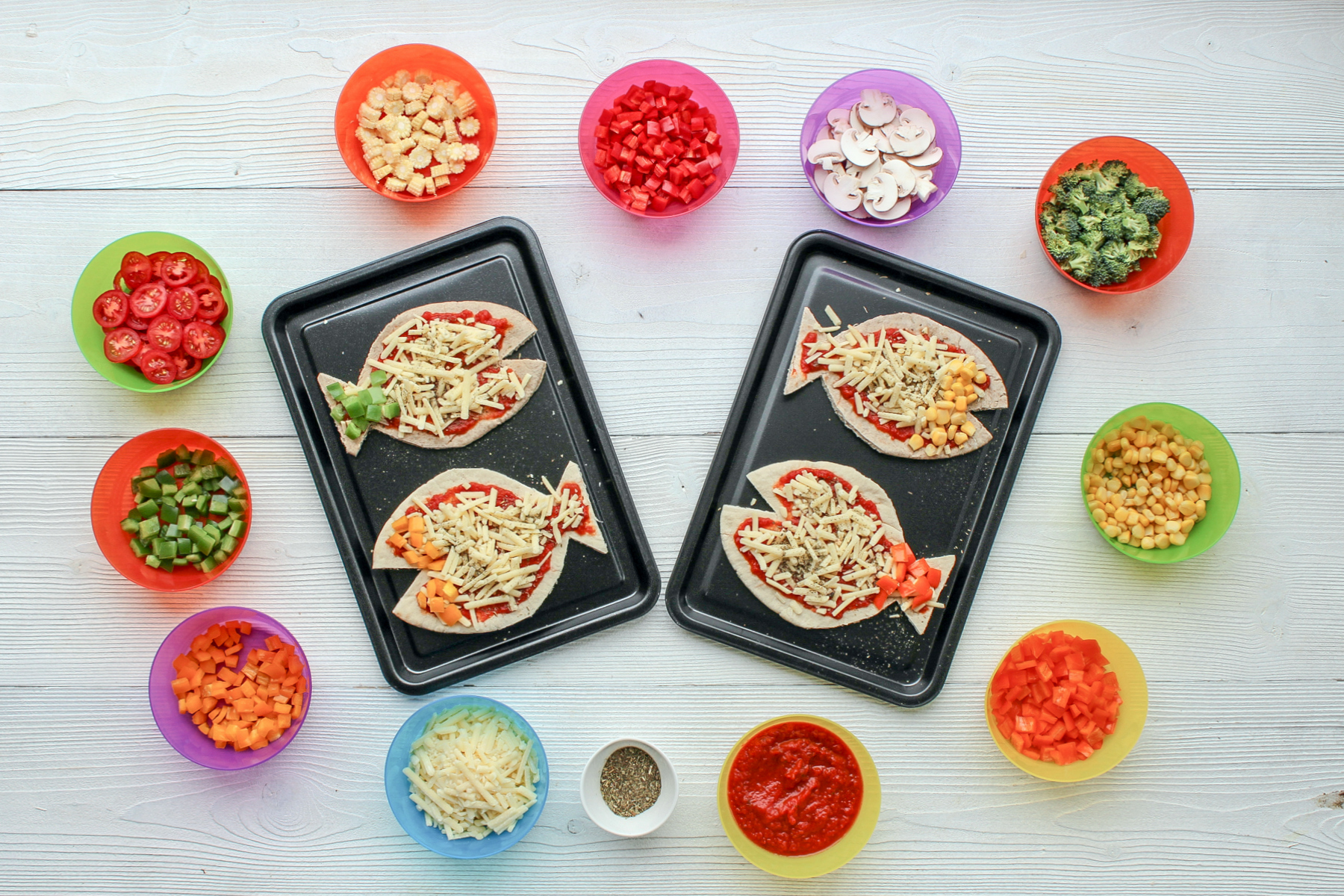
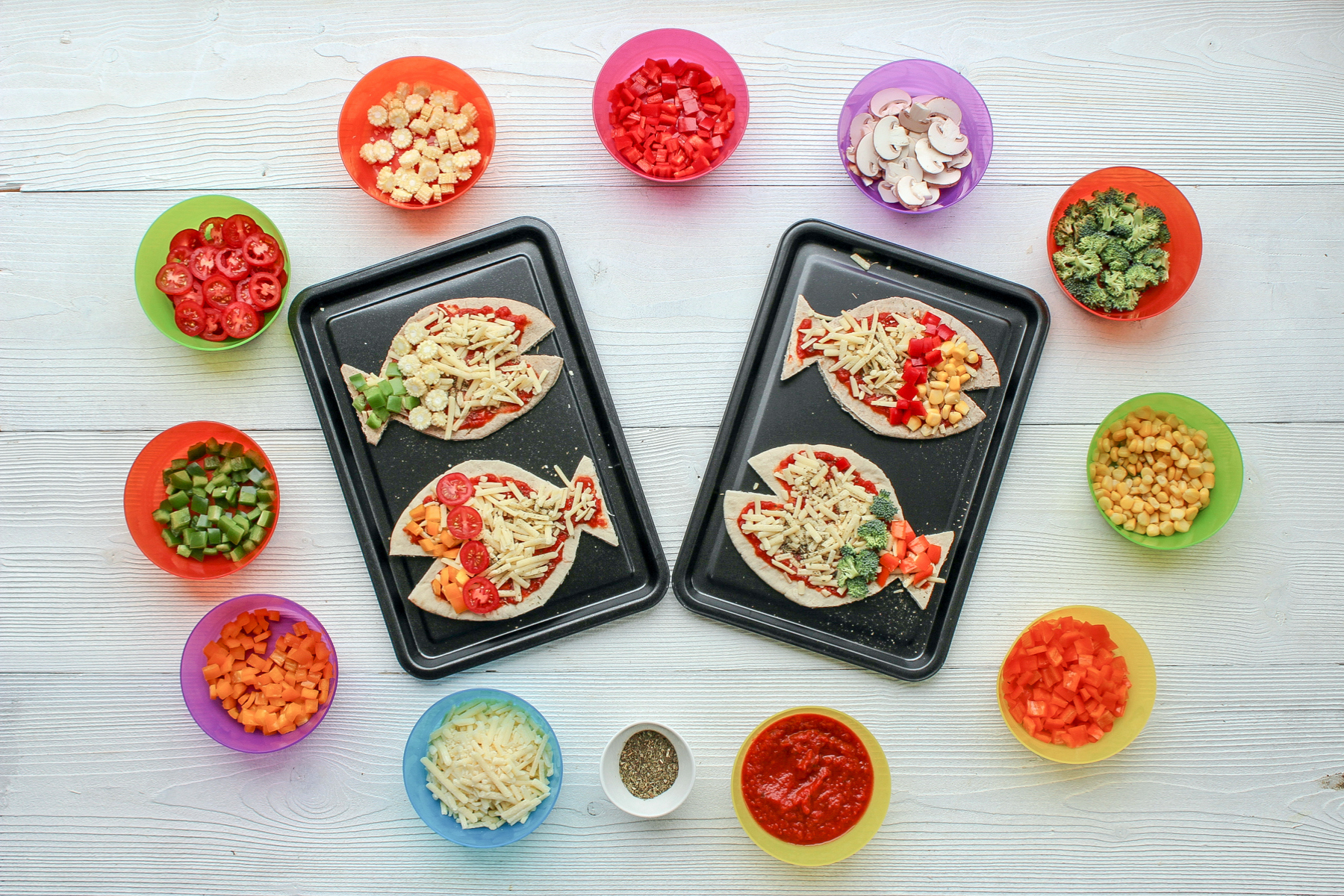
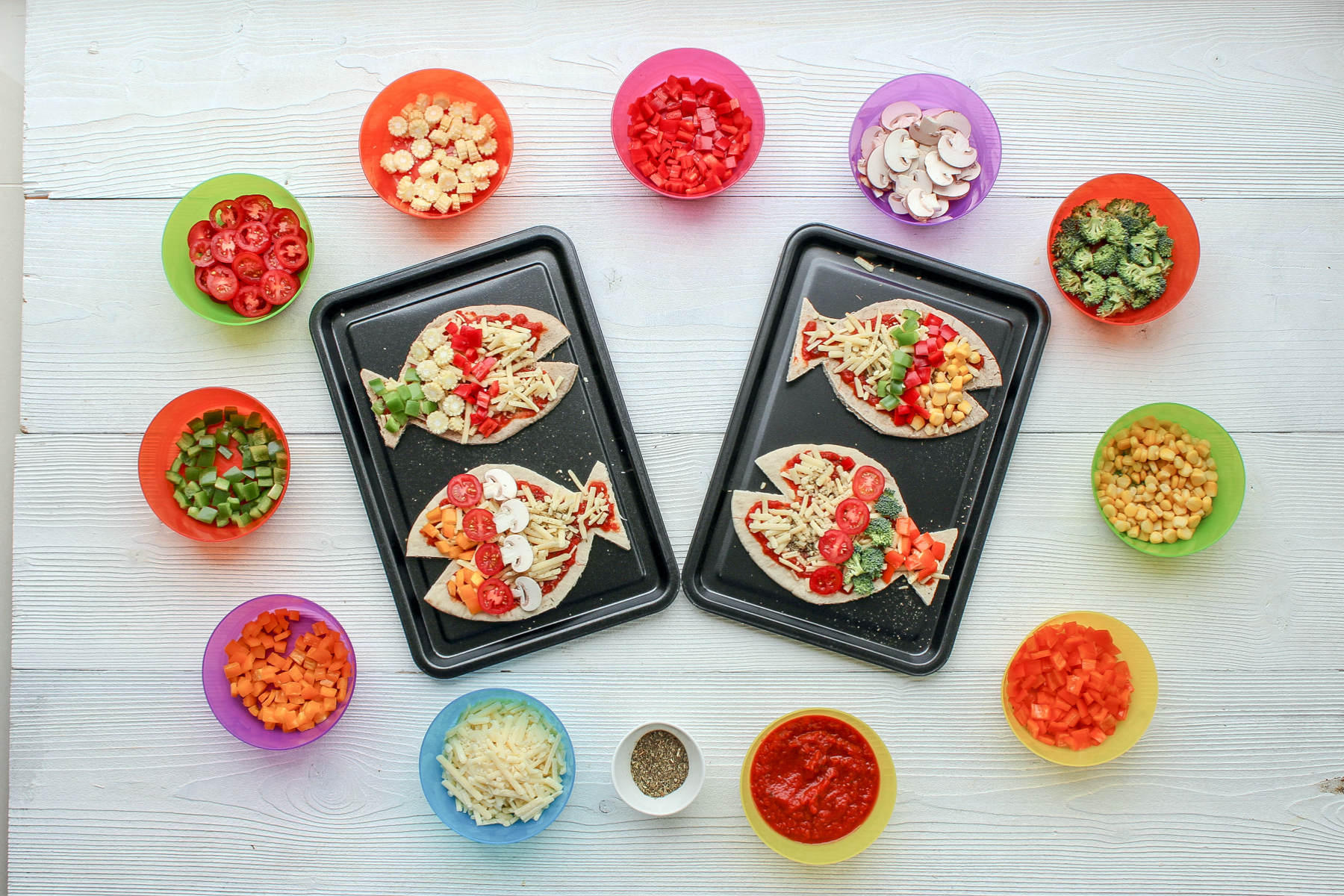
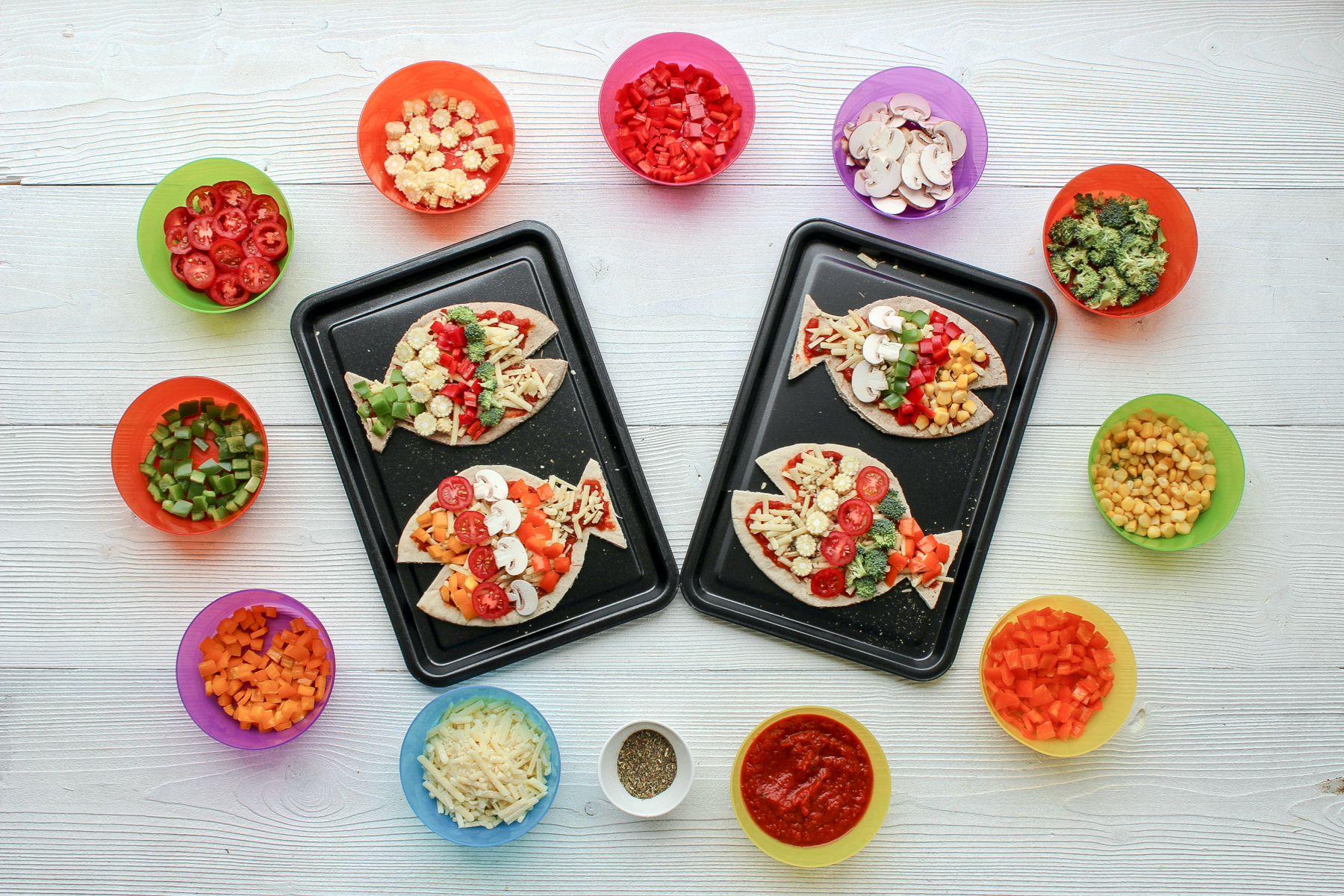
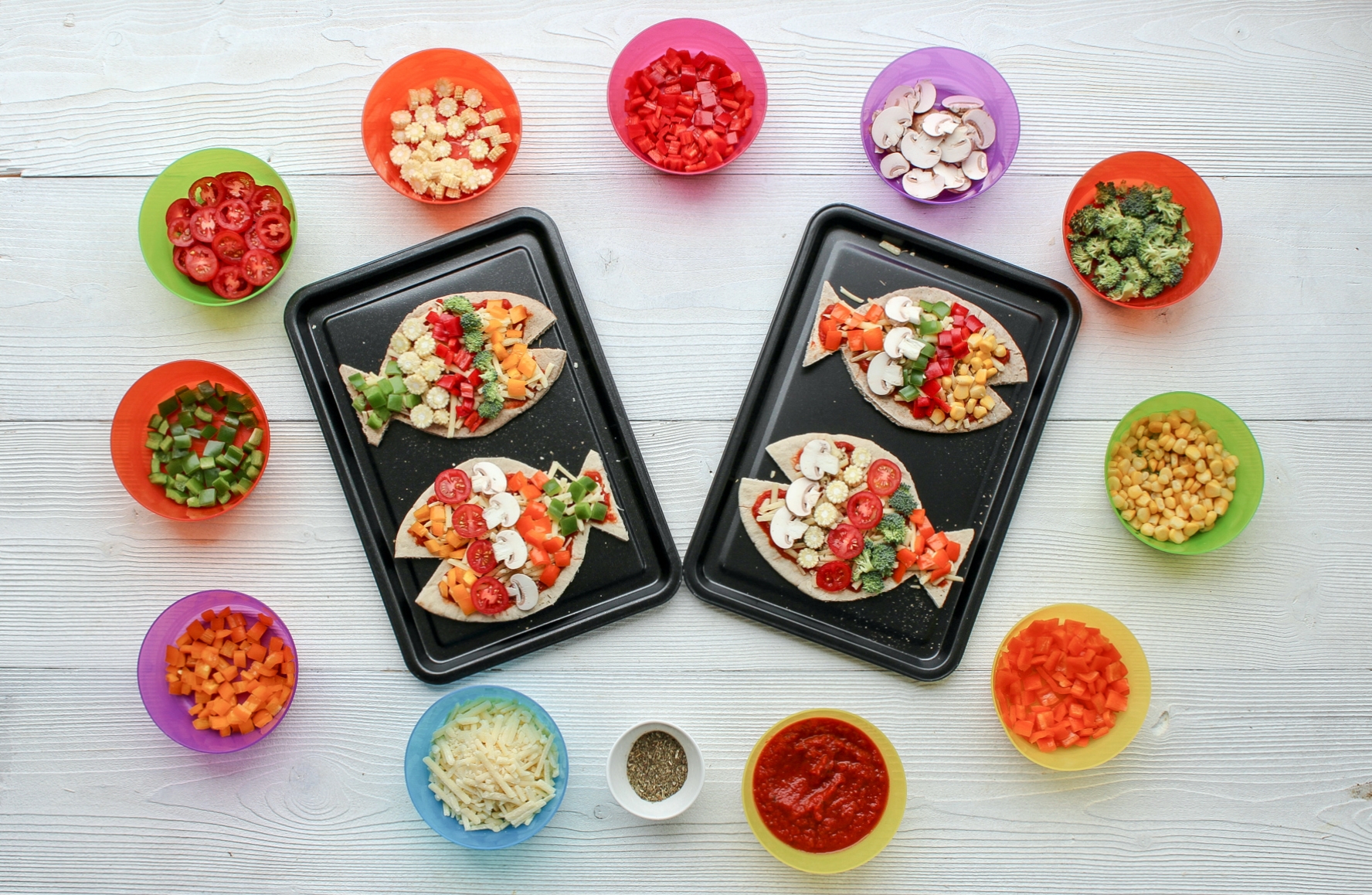
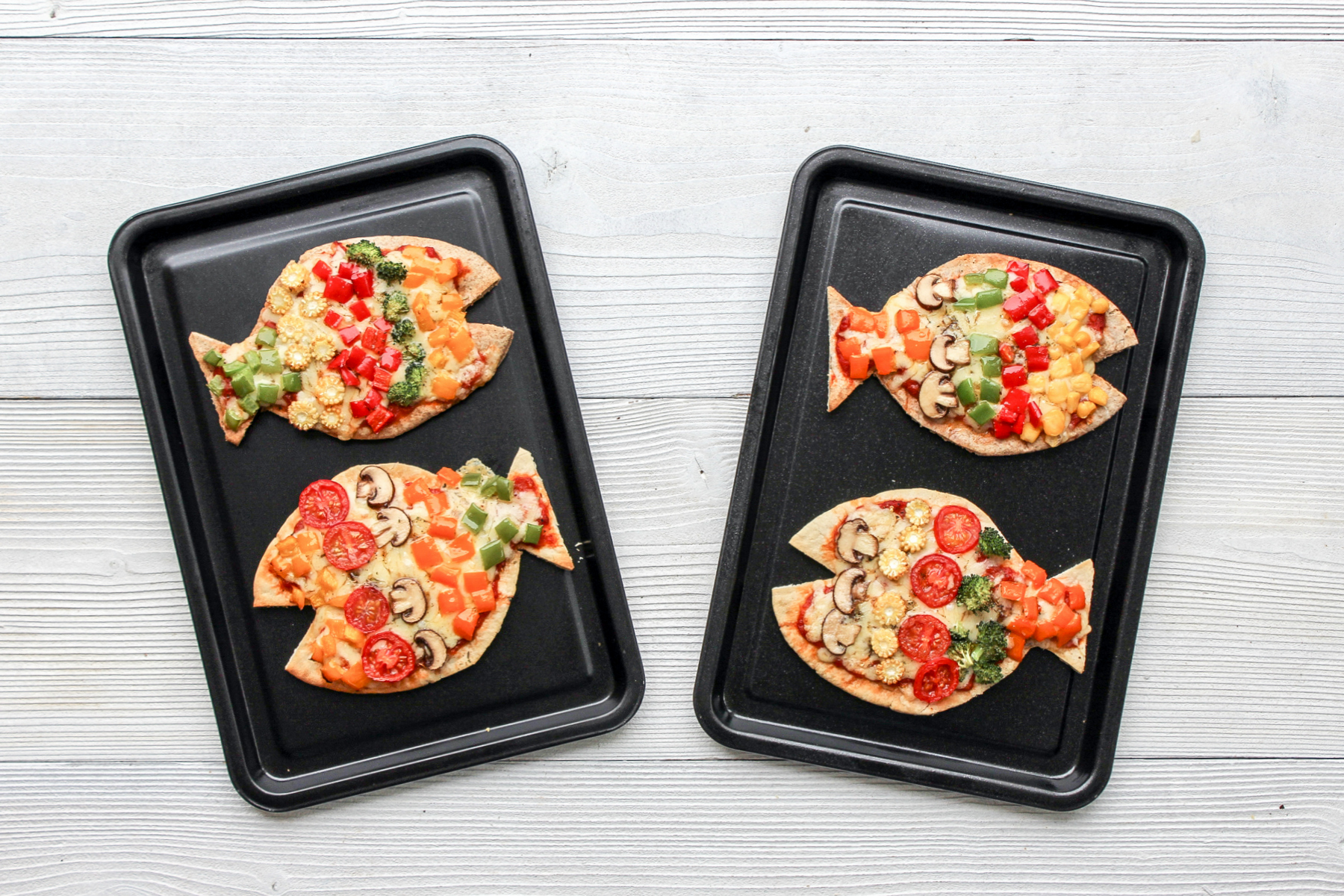
Developing cooking skills:
Encourage your children to do as much of the pizza prep as possible. We’ve highlighted the hands on skills they will be developing below:
Cut the pitta bread into a fish shape using scissors (adult/older child task unless very dextrous)
Spoon and spread pizza sauce (child)
Grate cheese and sprinkle over pizza sauce (child - may need support grating)
Take a pinch of italian herbs and sprinkle over cheese (child)
Prepare veggie toppings - dice and slice peppers, mushrooms, olives (child - younger cooks may need support slicing or offer strips which they can dice/snip with a safe knife or scissors)
Snip spring onions (if using) with scissors (child)
Build your rainbow fish pizza using fingers or a spoon to create colourful (veggie) rainbow scales (child)
Drizzle or spritz with a little olive oil - an oil spray works well for this (child - may need support)
Ask an adult to place in the oven for approx 12 mins (adult or older child)
Wait until cooled and enjoy.
Don’t forget to take some photos and share them with us in the Storytime Chef group (or tag us on instagram #storytimechef #organiccookeryschool)
Enjoy this? Try our Rainbow Fish inspired digestive biscuits.
Where to get hold of a copy of The Rainbow Fish:
Link to Rainbow Fish on Amazon UK Link to Rainbow Fish on Amazon US
Or don’t forget to check your local library.
By shopping with the links we have provided, we may earn a small referral commission which goes straight back into our community outreach projects for vulnerable families It also doesn’t cost you anymore. Thank you!
What Foodbanks really need after Christmas (apart from your leftover Quality Street)
Annual use of foodbanks is rising, so it’s bittersweet that so many of us are loosening out waistbands and still surrounded by the excesses of a typical British family Christmas.
And as New Year's Eve approaches, lots of these foods will soon be decluttered to make way for healthier January fare - the boxes of Roses from well-meaning aunties, packets of dates, sugared almonds and marzipan fruits from the neighbours, the family sized tubs of Celebrations, Twiglets and Mini Cheddars, being replaced with fresh fruit and veg, salads and smoothies.
Many of these unwanted treats will end up in food bank donation bins, where the basics of baked beans, tea bags and tinned veg are already shuffling for space with Christmas teas, fancy jams and endless Scottish shortbread.
And whilst the estimated 590,000 people per year who rely on food bank donations may welcome some of your Christmas leftovers, there are numerous essential items, often not food related, which are in greater need.
So next time you pass the food bank drop off at your local supermarket, church or community centre, please consider donating some of the following non food items too, as identified by The Trussell Trust.
Non food items to donate to your local Foodbank:
Deodorant
Toilet paper
Shower gel
Shaving gel
Shampoo
Soap
Toothbrushes
Toothpaste
Hand wipes
Laundry detergent or powder
Washing-up liquid
Sanitary towels
Tampons
Nappies
Baby wipes
Baby food (but not Baby Formula due to UNICEF regulations)
It’s also very helpful to check with your local foodbank as to which items, food or otherwise, they are particularly low on, or have plenty of.
Many, like Exeter Foodbank, issue a monthly priority list which you can find on their social media feeds.
If you and your family are struggling, you can find out more about being referred to your local food bank via the Citizen’s Advice Bureau.
How else can you help:
If you’d like to make a donation or volunteer to support the operation of your local foodbank, find out more here https://www.trusselltrust.org/get-involved/
In 2016/17, The Trussell Trust handed our over 1.8 million emergency food parcels. They operate a network of 400 foodbanks across the UK.
Bread and Butter Pudding Muffins
MAKES 16 MUFFINS
Lunch box staple and after school treat. These never last long in our household and are ideal to cook with little ones. Great for using up stale bread and a portable form of bread and butter pudding. Need we say more?
Did you know?
These muffins are full of calcium (good for your bones) and contains very little added sugar because of the natural sweetness of the dried fruit.
Cheese, Leek and Potato Pie
Here’s a popular dish from our Cooking with Dad project and afterschool clubs. Using cheap winter veg, tasty cheese and dried herbs, it’s inexpensive to make and delicious. You children will love getting creative with the pastry scraps too – so make sure there’s plenty left for all their decorations.
N.B. Children should always be supervised when cooking, and an adult should oversee the
use of heat as well as all preparation involving sharp utensils.
Try something different
Try using alternative vegetables in this pie. Peppers, sweetcorn, courgettes would all work well.
Did you know?
- Cheese contains both protein and calcium – something we all need for growth and development.
- For other interesting facts about cheese visit: www.britishcheese.com
Pear and Chocolate Pudding
serves 4
Low sugar and using store cupboard staples, this is perfect when you need a healthier chocolate pudding for the family. This goes down a storm in our community cookery classes and we’ve heard reports of it being served at fancy dinner parties. If you’re feeling indulgent throw in some extra dark chocolate chips ☺
Tip:
Younger children may prefer their pear cut into smaller chunks.
Optional chocolate sauce recipe:
Break 150g dark chocolate into pieces and melt in a bowl over simmering water, add a tablespoon of honey and a knob of butter and stir until combined and glossy. Slowly whisk in 100ml of warmed (but not boiling milk). Can be made in advance and reheated when ready.
Did you know?
- Pears are good source of dietary fibre, vitamins C and K and minerals such as copper and potassium.
- There are over 3000 varieties of pears grown around the world.
*Percent Daily Values are based on a 2,000 calorie diet for an adult. Your daily values may be higher or lower depending on your calorie needs. Infants and Toddlers will need less calories according to their age.
Click here for advice on how many calories your child needs.
Summertime Soup
serves 3 – 4
Try this if you’re making our potato, pea and mint puree for baby – it’s delicious and delightfully green. Also known as Mean Green Soup, we’ve yet to meet a child who doesn’t ask for seconds. And we’ve heard that lettuce has soporific qualities – perhaps a good sleep inducing supper.
N.B. Children should always be supervised when cooking, and an adult should oversee the use of heat as well as all preparation involving sharp utensils.
Try something different...
- This basic soup can be varied with whatever vegetables are in season. Swap potato for sweet potato, butternut squash or pumpkin, and onions for spring onion or leek.
- For information about what’s in season visit: www.eattheseasons.co.uk
Did you know?
- Soups can be thick or thin. A thin, clear soup is often referred to as a consommé.
- The potatoes and peas in this recipe which are blended together give this soup a thick consistency which is filling and satisfying.
Sweet Potato and Orange Muffins
makes 12-18
The apricots in this mix make these muffins – which are low in added sugar and full of natural sweetness from sweet potato, carrots, orange juice and dried fruit. We made them in standard muffin cases here, but they are perfect as mini muffins too – split the mix and have some mum and baby/toddler-sized ones. Perfect for lunchboxes and freezable.
* Adult supervision is required for all chopping, and use of ovens.
Did you know?
- Sweet potatoes are an excellent source of vitamin A (in the form of beta-carotene).
- They are also a good source of vitamin C, manganese, copper, pantothenic acid and vitamin B6. Additionally, they are a good source of potassium, dietary fibre, niacin, vitamin B1, vitamin B2 and phosphorus.
Try this!
Swap chopped apricots for any other favourite dried fruit – cranberries, raisins, even chopped prunes!
Tomato and Paprika Biscuits
makes 20 small biscuits
There’s something pretty unique about these biscuits – our very anti-tomato 10 year old loves them! As does pretty much everyone who’s made them in our community classes (even fussy eaters!) They can be thrown together in minutes, require pretty much store cupboard staples (just need to make sure you have a couple of spring onions to hand) and are perfect blw or lunchbox staples.
* N.B. Children should always be supervised when cooking, and an adult should oversee the use of heat as well as all preparation involving sharp utensils.
Did you know?
- The English word “tomato” comes from the Aztec word, “tomatl”. Tomatoes are full of health: A good source of vitamins A, C and E tomatoes also contain potassium which may help lower blood pressure and calcium which is vital for healthy bones and teeth.
- To read more about the humble tomato visit: www.britishtomatoes.co.uk
*Percent Daily Values are based on a 2,000 calorie diet for an adult. Your daily values may be higher or lower depending on your calorie needs. Infants and Toddlers will need less calories according to their age.
Click here for advice on how many calories your child needs.
Courgette, Pear and Carrot Cakes
makes two small loaves or 8 - 10 muffins
Here’s another low sugar lunchbox treat, which the kids will love making. Dead simple, packed with veggies and naturally sweet with very little added sugar. We regularly make these in our Little Foodies toddler cookery classes, and everyone loves them.
Need any further excuse to try them?
Carrots are rich in beta carotene which is converted in the body to vitamin A. This nutrient is used to strengthen the immune system and to ensure good eye health. Courgettes are also a good source of vitamins A and C, as well as folate and potassium and fibre, which help to ensure a healthy bowel and prevent constipation in little ones.
*N.B. Children should always be supervised when cooking, and an adult should oversee the use of heat as well as all preparation involving sharp utensils.
Try something different
- Try changing the pear for another fruit or your choice. Apples, plums and peach would work well.
Did you know?
- Courgette (also known as Zucchini) contains more potassium than bananas and are a rich source of vitamin C and manganese.
- Carrots although usually orange in colour can also come in purple, red, white, and yellow varieties.
- The human body turns beta-carotene from carrots into vitamin A. Vitamin A is important for the health of our vision (including our night vision) as well as our bones, teeth and skin.
*Percent Daily Values are based on a 2,000 calorie diet for an adult. Your daily values may be higher or lower depending on your calorie needs. Infants and Toddlers will need less calories according to their age.
Click here for advice on how many calories your child needs.
Cheesy Spinach and Apple Muffins
Perfect for babies and toddlers
If your children are bored of sandwiches, these are great in lunchbox ( perhaps with some cooked chicken or a boiled egg for extra protein). Loved by toddlers, fussy eaters and baby-led weaners they freeze perfectly and are our secret weapon for sneaky some extra veggies into our little ones diets. We’ve made these as full sized muffins, but they work just as well as mini muffins for babies and toddlers.
*Percent Daily Values are based on a 2,000 calorie diet for an adult. Your daily values may be higher or lower depending on your calorie needs. Infants and Toddlers will need less calories according to their age.
Click here for advice on how many calories your child needs.
Cheesy Courgette Bake
to serve 2 adults or 4 children (double quantities for a bigger family)
Another toddler friendly veggie smuggling dish – get your kids grating the courgettes and squeezing out the excess water, and throw in some cooked new potatoes for a substantial veggie side. Perfect for BBQs or summer lunches, just double or triple the quantities to feed a family.
Try something different:
- Swap sweetcorn for peas, and add a teaspoon of chopped mint.
- Or added cooked new potatoes or cooked bacon to make a meal.
Did you know?
- Courgettes (also known as zucchini) are rich in Vitamin A and potassium. They are normally a bright dark green but can also be golden yellow.
*Percent Daily Values are based on a 2,000 calorie diet for an adult. Your daily values may be higher or lower depending on your calorie needs. Infants and Toddlers will need less calories according to their age.
Click here for advice on how many calories your child needs.
Magic Tomato Sauce
serves 4 as a pasta sauce
Another recipe on our ‘most popular list’. This basic tomato sauce is packed with flavour and can be blended smooth or chunky depending on your family’s preferences. It’s a great base for pizzas, pasta, bolognaise, lasagne, chilli and anything needing a rich tomato base. And look at the veggies we are sneaking in!
Serving suggestion:
Delicious served over pasta. Makes an excellent tomato base for pizzas. Can also be used as a sauce for chicken or fish or used as a dip for vegetables and pitta bread. Freezes well.
Try something different…
- Add other coloured peppers, aubergine, celery, a handful of parsley and /or basil to your sauce… a great way to get children eating some healthy veg.
- If you don’t have balsamic vinegar, substitute for a tablespoon of sugar.
Did you know?
- Tomatoes are a great source of vitamin A and C.
- Although the tomato is closely associated with Italian and Mediterranean cooking, the tomato originally comes from America and was only first introduced to Europe in the 16th century.
- For more information about tomatoes visit: www.thetomatozone.co.uk
*Percent Daily Values are based on a 2,000 calorie diet for an adult. Your daily values may be higher or lower depending on your calorie needs. Infants and Toddlers will need less calories according to their age.
Click here for advice on how many calories your child needs.
